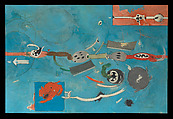The Guide (Éclaireur)
Hervé Télémaque Haitian
Télémaque, whose family was involved in the Black consciousness movement in Haiti, encountered Surrealism when he left Haiti at the age of twenty to study at the Art Students League in New York. Rejecting the endemic racism of the U.S., he went to Paris in 1961, where he befriended André Breton and a younger generation of Surrealists. While the artist later developed a style of representational painting associated with Pop and the leftist politics of the Narrative Figuration group, Télémaque found in Surrealism a means to negotiate his creative identity in relation to his Caribbean roots.
Éclaireur was made at that significant point in his career. Against a brilliant blue background that suggests sea and sky, organic forms undergo metamorphosis; some seem to stretch and twist with gaping black holes like wounds or mouths filled with teeth. The painting’s shifting imagery may suggest the artist’s articulation of his new artistic path: its French title Éclaireur can mean guide or scout, as in something that helps inform in advance.
This image cannot be enlarged, viewed at full screen, or downloaded.

